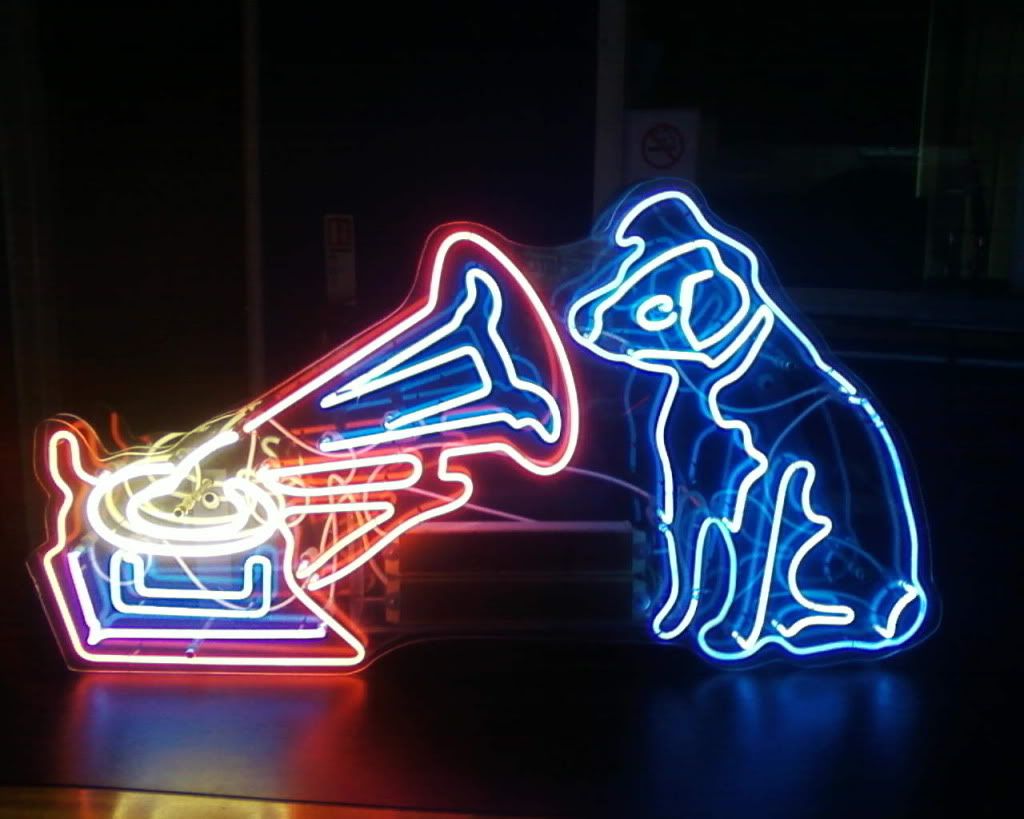Nipper was the terrier that, around the beginning of the 20th century, was pictured listening to a gramophone. He became the much-loved trademark for the Victor Talking Machine Company, RCA Victor, HMV, and other record labels. Nipper continued to adorn labels of RCA LPs into the 1950s, and his image has been periodically revived.
Plaster casts of Nipper were available for sale at the Capital Audiofest, which I attended this weekend, in the Maryland 'burbs of Washington. A medium-size Nipper went for $37, and was practically the only item at the show I could afford. The Audiofest was a venue for demonstrating high-end audio equipment. High-end means, "If you have to ask how much it costs ... ."
Why go to the event if the gear would have knocked my budget into origami? I wanted to see (and, of course, hear) the changes the audio industry has gone through since I worked at Santa Fe Sight & Sound in 1988-1991. Even then it was tough to keep up with the new technology. Now it has gotten still more esoteric.
At least a couple of dozen manufacturers and one high-class retailer had rooms with elaborate set-ups of components and connections, designed to show what their products could do. In some ways the Audiofest resembled the Consumer Electronics Show in Las Vegas I went to as an SF Sight & Sound employee, but this was more comfortable. It was limited to audio, unlike the CES (which had everything from car alarms to -- I kid you not -- a huge room dedicated to "adult" movies, with some of the, uh, actresses as greeters). It was large enough to be able to audition many systems, but not so huge as to generate listening fatigue -- well, not until it was getting toward the end of the day.
I've kind of followed the progress of the industry through publications like Stereophile and The Absolute Sound. But I don't go to high-end retail showrooms. Not because I can't resist temptation, but because it isn't ethical to take up salespeople's time when what they are selling is beyond my means. However, the Audiofest was different; you paid for admission and that entitled you to wander at your heart's content from one demo to another.

Music software increasingly consists of computer downloads rather than compact discs, or computer downloads onto CDs. Interestingly, while almost all the systems included CD players and turntables for vinyl LPs (all the fashion these days), in many cases they were secondary to computer files as sources for the playback demonstrations.
The problem with downloads is that most common file types, especially the dreaded MP3s, are compressed and the sound is compromised. I talked with one of the experts on hand about lossless compression for downloads, mainly .FLAC files. If I understood correctly, the trouble is that no equipment other than computers can play .FLAC recordings; they have to be converted to .WAV, which do retain all the original bits and sample rates (now often 24/96 or greater). It just seems like too much of a pain. When lossless downloads become easier, as they surely will, I'll sign on.
Separate digital-analog converters (DACs) seemed ubiquitous. A CD player has its own DAC, but like all components that marry different functions (in this case, the disc reading mechanism and the conversion of digital information to an analog signal), it is said that some compromise is involved. Voilà: your dedicated DAC housed in its own box. (I'd always pronounced it in my mind as "D-A-C," but the pros said "Dack.")
The demographics of the attendees were interesting. Unsurprisingly, 90 percent male, with a few wives and girlfriends; didn't see any women who appeared to be there on their own or with women friends. Generally middle aged or older. Prosperous-looking, no Great Recession here.
What did surprise me was how many well-to-do blacks were in attendance. The Maryland suburbs have a high black population, and I would guess most of those I saw at the show wear (or used to wear) U.S. government ID badges as bling during the week. To be fair, the same is probably true of many of the white men who showed up.
Many of the blacks brought their own CDs or LPs to listen to on the high-end systems; their music was generally jazz, and good stuff. I have always found jazz to be a good meeting ground with African Americans, and I tried to start up a conversation about recordings we were hearing, for instance Gene Ammons's Boss Tenor, which is in my own collection. (Serious listening was going on, but the semi-partylike atmosphere encouraged conversation.)
My attempts at cross-cultural interaction were disappointing. None of the blacks I tried to chat up were rude or hostile, but I got a lot of short replies and the impression they didn't have a lot of time for whitey's enthusiasms about "their" music.
Back to the sound reproduction. Were the examples of systems that cost more than my annual income mind-blowing? In a few cases, yes, but not necessarily. And given that each manufacturer was showing off what they considered their best products, it was remarkable how different they sounded from one another. All were impressive, but in different ways, some of which I liked, some not so much.
One problem was the music chosen by the proprietors for their demonstrations. Lots of jazz, particularly featuring extended drum solos. Some rock, which is useless for demonstrating accuracy: with electronic instruments, there is no way to know what they "really" sound like. It's understandable that a proto-sales event for big-bucks equipment encourages playing knock-your-socks-off recordings ... but really. High enders: can we take it as a given that all these systems with eye-watering prices are brilliant at transients (drum thwacks, plucked strings, etc.)? I want to know what they can do with more subtle and varied music. Eventually I went out to my car and pulled a disc out of the CD player, Brahms's Third and Fourth Symphonies conducted by the late Sir Charles Mackerras. I requested it be auditioned on two different mega-systems, and the manufacturer representatives were glad to oblige. The results were eminently satisfying.
These are hard times for high-end audio, a low-volume business at best and lower still in today's economy. But it was obvious at the Audiofest that there are still people who care about building equipment to make reproduced music come alive. Even though many of them could probably make more money at something else, their commitment to bringing the world's great musicians virtually into the homes of their customers is admirable.
Oh, about that sculpture of Nipper. I considered buying it, but the seller said it was the only one left, and I sensed that he wasn't too keen on letting it go. Good on him. Besides, $37 is a lot of money.




7 comments:
For me, Nipper is associated with the phrase "la voix de son maître", which I think was a jolly good slogan!
This FT article
http://www.ft.com/intl/cms/s/2/5e37eb34-74e0-11df-aed7-00144feabdc0.html#axzz1RpKv88OU
...suggests that the earphones/headphones used by most people are so sucky that they are the worst link in the reproduction chain
David,
The people who listen to crap music through crap sound systems also use crap headphones.
I don't know Jimmy Iovine or Dr. Dre but I strongly suspect their "music" falls in the crap squared category. There is a grain of truth in what Iovine says, though. You can get astonishingly good performance value-for-money from well-designed headphones coupled with decent electronics or even direct from the front end. My AKG-701 cans are plugged into the Onkyo two-channel SACD player and the realism is dazzling, even without an outboard headphone amplifier.
Hi Rick,
Sadly, a lot of people, when given blind tests, actually prefer the sound of compressed audio.
I remember when digital recording equipment (low-resolution samplers and audio workstations) first became cheap enough to be available to the general public. It immediately gave rise to a wave of lo-fi "outsider" recordings, mostly in the then-nascent field of hip-hop. This unpolished sound very quickly became "edgy" and fashionable. I remember sitting at the console on several occasions and having the producer tell me "now don't make it sound too good!"
Something else worth mentioning: audiophiles are often surprised to find that the albums they listen to on their Snell Reference Towers were recorded and mixed on a $300 pair of Yamaha NS-10s...
Malcolm,
I'm delighted that you read my posting.
Yes, there are all sorts of paradoxes involved in high-end audio. It can be sublime if the recording and mix are well done, but it shows up mediocre recordings for what they are. And if you get too involved with audiophilia, it's easy to fall into an obsession with sound per se and forget you're listening to music.
I'm going to upgrade one of my CD players to either an Onkyo CS5VL or Marantz CD 5004. Not because I urgently need to right now but because quality mid-price stand-alone CD players are quickly vanishing from the market. Soon there will only be very expensive ones for the rich and MP3s for the proles.
Do you think a separate DAC is likely to make a significant improvement? It seems to be something every self-respecting audiophile has to have now, but I'm not sure if it isn't just a triumph of marketing.
Incidentally, in one showroom at the Audiofest,the set-up included a separate crossover for the speakers. O brave new world!
Near where I grew up in Fairfax, VA, there was a guy with a nice piece of land right on Lee Highway (near Captain Pell's Crabhouse) who had a big statue of Nipper and the Gramophone out on his land. I'd see it every day on the bus to school.
It was a big statue, I'm afraid to guess how tall, but it was huge.
"it's easy to fall into an obsession with sound per se and forget you're listening to music."
Yes, and that's a real trap for some engineers too, I think -- especially young ones who feel they have to make their mark, and who haven't yet learned to get out of the way.
I'm no expert on consumer audio, but there are high-end CD players that have good converters built in. If you don't want to go for one of those, then an external converter can make an audible difference, if your amp & speakers are good enough to reveal it. When mastering albums to CD from an analog source, it's not uncommon for the producer and the mastering engineer to listen to several different converters to pick the one that works best with the particular program material.
Keep in mind that CDs, which use a 44.1 Khz sampling rate and a 16-bit word size, are still using 1980s audio standards. In professional studios, recordings are now usually made at 24-bit resolution, with sampling rates as high as 192KHz. It's shocking that the consumer standard has fallen so far behind what's used in the studio, but the bottom line is that nobody seems to care.
And yes, active crossovers and bi- or tri-amped monitors have been around for a long time...
Post a Comment